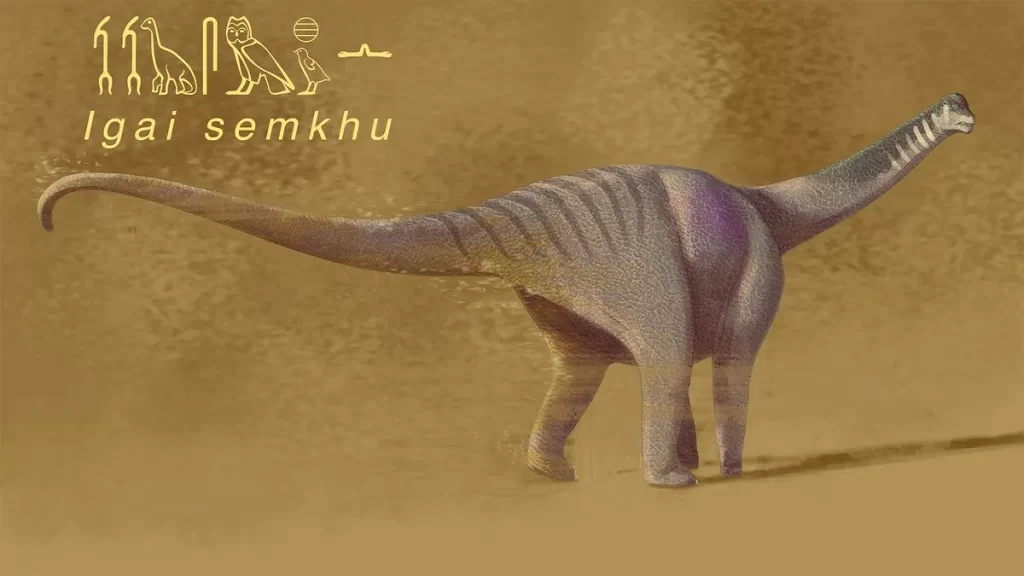
Egyptian titanosaur fossils from 75 million years ago fill a “black hole” in the history of dinosaurs.
A gap in our knowledge of the dinosaurs of Africa has been filled by a newly identified titanosaur species that bears the name of an ancient Egyptian deity.
After being discovered in the Egyptian desert nearly 50 years ago, a peculiar species of miniature titanosaur has now been given a name.
Igai semkhu, a newly discovered species, lived in the Kharga Oasis 75 million years ago.
Hieroglyphic representations of the name Igai semkhu, which means “Forgotten Lord of the Oasis” in ancient Egyptian, exist. According to research author and palaeontologist at the Carnegie Museum of Natural History Matthew Lamanna, “it’s named after a deity the Ancient Egyptians would have worshipped in the oasis it came from.”
A “mere” 33 to 50 feet (10 to 15 metres) long, the comparatively little titanosaur was reported in the Journal of Vertebrate Palaeontology in July 2023.
There is undoubtedly cause for celebration, according to Lamanna. “It is helping fill in this black hole in our understanding of the final 30 million years of the Age of Dinosaurs on one of the largest landmasses on Earth.”
Igai semkhu was first extracted from rocks in the Western Desert of Egypt in 1977 by German researchers, but the specimen was lost for many years until Lamanna and his colleagues gave it a second look.
It became out that I. semkhu was a titanosaur, a subclass of sauropods, with a previously unidentified genus and species. Plant-eating sauropods had large, elephant-like bodies, long necks, and small skulls.
But by the time Igai semkhu was likely living 75 million years ago, the majority of sauropods had already gone extinct, leaving titanosaurs as the sole sauropod lineage to survive during the Cretaceous period (145 million to 66 million years ago).
Related: The-necks-of-long-necked-dinosaurs-were-likely-even-longer-than-previously-believed
Titanosaurs, despite their name, weren’t all enormous. “Titanosaurs range from some of the smallest sauropods ever found, about the size and weight of a cow, all the way up to the size of a humpback whale,” Lamanna added. They were considered “the largest land animals to have ever existed.”
Igai semkhu falls in the middle of these two extremes. A pair of leg bones—the tibia and fibula—helped research co-author and palaeontologist Eric Gorscak of Midwestern University determine the size of I. semkhu. The upper estimate would put it “slightly below average” in terms of size, Lamanna said, being around the length of a school bus.
It is impossible to tell exactly what I. semkhu looked like because all that is left of it are a few leg bones and some vertebrae, according to Lamanna.
I. semkhu is one of the most complete dinosaur fossils ever discovered in Africa, where known dinosaur fossils are rather scarce, despite the limited fossil evidence that exists.
“When you are talking about continental Africa,the last 30 million years of the dinosaur record are almost non-existent,” Lamanna stated.
This is partially due to the fact that palaeontologists haven’t been excavating in Africa for as long as they have elsewhere. Moreover, although the continent is home to a large number of Cretaceous-era rocks, very few of them are conveniently accessible. Numerous fossil-possible sites are either completely obscured by dense flora or by deep desert sands.
The newly discovered titanosaur is significant because of its rarity.
According to John Whitlock, a professor of anatomy at Mount Aloysius College in Pennsylvania who was not involved with the work, “Igai is, although still fragmentary, complete relative to the rest of the record, and is therefore a pretty significant addition to our understanding.”
Source: Live Science



